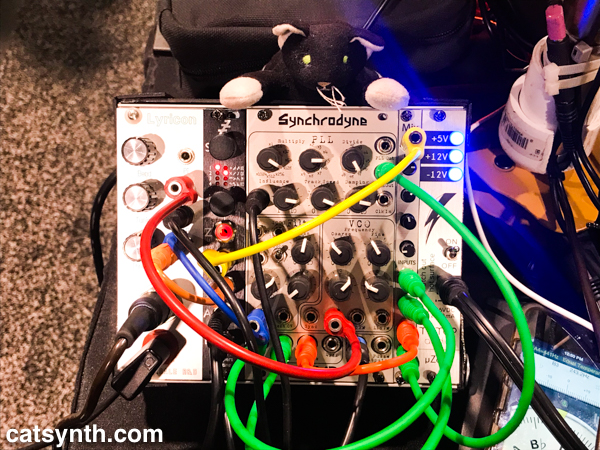This performance, entitled FUEL, was part of the Containment Scenario performance series “which explores the current environmental situation through the lens of improvisational music-dance-theater.” This was the third part of a five-part series adopted from the book Containment Scenario: DisloInter MedTextId entCation: Horse Medicine by M. Mara-Ann, who also directed this performance.
This was a multimedia piece with voice, text, instruments, dance and reactive video (Luke Selden). It began with the vocal leads (M. Mara Ann and Sarah Elena Palmer) sitting down in the front of the stage with computer printouts, loudly ruffling and connecting them up with packing tape. As video of bucolic grass scenes and a close-up of a human are projected on the walls behind them (and onto their reflective white dresses), we hear their voices come in, speaking words disjointed and percussively. The voices gradually become more melodic, but all the while the “paperwork” continues. The other performs move slowly onto the stage, all wearing white shirts. As they take their positions, first the guitar (Noah Phillips), then the electronics (Travis Johns), then violin (Emily Packard) and percussion (Anantha R. Krishnan) all came in.

Musically the texture remained very gradual, interspersed with vocals, though the words became clearer and louder over time. This was aided by the fact that the text (presumably from the Containment Scenario source) became synchronously part of the music and the projected media. Text scrolling by on the right video projection was recited in various musical styles, harmonic, percussive, expressive, while the vocalists took turns typing their words into a laptop that would project onto the other screen, sometimes mixed with other videos. During this section, the instrumental music was much more sparse, often silent as the written and spoken words became the focus.
Later textual recitations returned from the video to the computer printouts. At times the words came out as whispers, sometimes more melodically, with the instrumentals returning into the mix. As the performers moved around the stage, there were dramatic visual moments where they became part of the video projection, their white shirts and dresses becoming screens on which the video was reflected and distorted and combined with the flat background.

The dancers (Julie Binkley and Rebecca Wilson) eventually took the printouts used for the back screen and began to wrap each of the musicians in a cocoon of paper. First Travis Johns on electronics was encased, then the each of the others in succession, eventually binding the two vocal leads into a bundle of their own printouts. The piece concluded with the dancers bringing out large number signs (I’m not sure what these were about), and handing them to the vocalists, after which the sounds and words gradually stopped.
The performance of Containment Scenario: FUEL was preceded by two fun sets of improvisational music.
The first set was by Drew Ceccato, playing an electronic valve instrument (EVI) by Steiner and an analog synth by Crumar – a beautiful and intriguing instrument. The set began with a low rumbling, which joined with “watery” sounds and pitch modulation expressively controlled by the EVI to create a subtle rhythm. Over time, this become louder, with wider pitch modulations, beating, percussive sounds before returning to the low rumbling. The music then changed completely for more traditional “analog sounds” with traditional pitched notes, like a conventional wind instrument, though with extremely high pitches at times. It was a very brief, and very intense set, without a moment wasted.
Ceccato was followed by a duo of Gino Robair and Christopher Riggs who was playing “guitar and a box of cool looking stuff”. Of course, Gino Robair had his collection of cool stuff as well, analog synthesizers along with metallic resonant objects and various means of exciting them. It started with a metallic roar, which I believe was created by Riggs’ rubbing the guitar strings. This was combined with the chaotic sound of the Blippo Box and other synths. The two performers appeared to come to an equilibrium of sorts, with sounds repeated and played off one another. Indeed, it was sometimes hard to tell who was playing what sound – and this is a good thing. Robair moved on from the synths to cymbals, with loud dramatic resonances set against the guitar rhythms. I heard a plaintive brass synth set against a more “chattery” guitar; a styrofoam instrument that was “insect-like” in both its appearance and sound; a funny voice vaguely like throat singing made with a tube and a coffee can; and more metal objects excited by motorized fans crawling along the floor. After a climx with angry resonances and a metal on metal thud, lots of motion, convulsing and fast scraping, the sounds faded out.
The turnout for this particular evening was quite impressive, it seemed that all the seats were filled, even the extra “kiddie seats” that the folks at the Luggage Store often put out.



